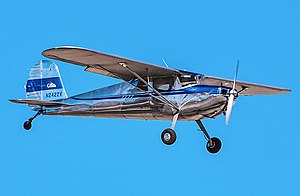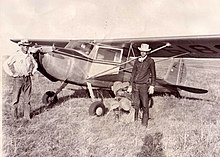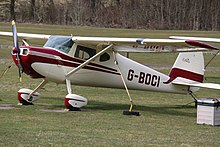Cessna 140
| Cessna 120 & 140 | |
|---|---|
 Cessna 140 | |
| General information | |
| Type | Light utility aircraft |
| Manufacturer | Cessna Aircraft Company |
| Number built | 7,664 |
| History | |
| Manufactured | 1946–1951 |
| Introduction date | 1946 |
| First flight | June 28, 1945 (140) 1946 (120)[1] |
The Cessna 120, 140, and 140A, are single-engine, two-seat, conventional landing gear (tailwheel), light general aviation aircraft that were first produced in 1946, immediately following the end of World War II. Production ended in 1951, and was succeeded in 1959 by the Cessna 150, a similar two-seat trainer which introduced tricycle gear. Combined production of the 120, 140, and 140A was 7,664 units in five years.[2][3]
Development
Cessna 140

The Cessna 140 was originally equipped with a Continental C-85-12 or C-85-12F horizontally opposed, air-cooled, four-cylinder piston engine of 85 hp (63 kW). The Continental C-90-12F or C-90-14F of 90 hp (67 kW) was optional, as was the 108 hp (81 kW) Lycoming O-235-C1 engine, an aftermarket installation authorized in the type certificate. This model had a metal fuselage and fabric wings with metal control surfaces. The larger Cessna 170 was a four-seat 140 with a more powerful engine.[2][3][4]

Cessna 120

The Cessna 120 was an economy version of the 140 produced at the same time. It had the same engine as the 140, but lacked wing flaps. The rear-cabin "D" side windows and electrical system (radios, lights, battery and starter) were optional.[2][3][4] A 120 outfitted with every factory option would be nearly equivalent to a 140, but the International Cessna 120/140 Association believes that no 120s were originally built this way. Despite this, many decades' worth of owner-added options have rendered many 120s almost indistinguishable from a 140 aside from the absence of wing flaps.[5] The 120 was dropped from production upon introduction of the 140A in 1949.[5]

Cessna 140A

In 1949, Cessna introduced the 140A, a new variant with aluminum-covered wings and single wing struts instead of the fabric wing covering, dual "V" struts, and jury struts fitted on earlier models. Standard engines were the Continental C-90-12F or C-90-14F of 90 hp (67 kW), with the 85 hp (63 kW) Continental C-85-12, C-85-12F, or C-85-14F engines optional. The spring-steel gear had been swept 3 in (8 cm) forward on 120 and 140 models in late 1947 so landing gear extenders were no longer necessary to counter nose-over tendencies during heavy application of brakes; all 140A models had the improved gear legs.[2][3][6][7][8] Despite these improvements, sales of the 140 lineup faltered, and the 140A comprised only seven percent of overall 120/140 production.[5]
Modifications
Common modifications to the Cessna 120 and 140 include:
- "Metalized" wings, where the fabric is replaced with light-gauge sheet aluminum, eliminating the need to periodically replace the wing fabric.[2][5]
- The installation of landing gear extenders to reduce the tendency of the aircraft to nose over on application of heavy braking. These were factory-optional equipment.[5][9]
- Installation of rear-cabin "D" side windows on 120s that were not originally so equipped.[5]
- Installation of electrical systems on 120s that were not originally so equipped, allowing owners to install an electric starter, more sophisticated avionics and/or lights for night flying.[2][5]
- Installation of a more powerful engine. A popular conversion today is to replace the original C-85 or C-90 with a 100 hp (75 kW) Continental O-200. A kit is available to install a Lycoming O-320 but this conversion is less prevalent due to a roughly 100 lb (45 kg) weight penalty and a sharp increase in fuel consumption.[5]
Operators
Military
Specifications (Cessna 140)

Data from The Complete Guide to the Single-Engine Cessnas,[2] AOPA Pilot,[5] and Aircraft Specification No. A-768.[4]
General characteristics
- Crew: one
- Capacity: one passenger
- Length: 21 ft 6 in (6.55 m)
- Wingspan: 33 ft 4 in (10.16 m)
- Height: 6 ft 3 in (1.91 m)
- Wing area: 159.3 sq ft (14.80 m2)
- Empty weight: 890 lb (404 kg)
- Gross weight: 1,450 lb (658 kg)
- Fuel capacity: 25 US gallons (95 liters), of which 21 US gallons (79.5 liters) are useable
- Powerplant: 1 × Continental C-85 four cylinder, four stroke, horizontally opposed aircraft engine, 85 hp (63 kW)
- Propellers: 2-bladed Sensenich[5]
Performance
- Maximum speed: 125 mph (201 km/h, 109 kn)
- Cruise speed: 105 mph (169 km/h, 91 kn)
- Stall speed: 45 mph (72 km/h, 39 kn) flaps down
- Never exceed speed: 140 mph (230 km/h, 120 kn)
- Range: 450 mi (720 km, 390 nmi)
- Service ceiling: 15,500 ft (4,700 m)
- Rate of climb: 680 ft/min (3.5 m/s)
- Wing loading: 9.1 lb/sq ft (44 kg/m2)
See also
- 1945 in aviation (first flight)
Related development
Aircraft of comparable role, configuration, and era
References
- ^ Simpson, Rod: The General Aviation Handbook, Midland Publishing 2005, ISBN 1-85780-222-5, p.81.
- ^ a b c d e f g Christy, Joe: The Complete Guide to the Single-Engine Cessnas - 3rd Edition, pages 12-17. TAB Books, 1979. ISBN 0-8306-2268-3
- ^ a b c d Plane and Pilot: 1978 Aircraft Directory, page 22. Werner & Werner Corp Publishing, 1978. ISBN 0-918312-00-0
- ^ a b c Federal Aviation Administration (July 29, 2015). "Type Certificate Data Sheet No. A-768" (PDF). Retrieved August 19, 2022.
- ^ a b c d e f g h i j Twombly, Ian J. (October 2011). "Budget Buy: Drag your tail - cheaply!". AOPA Pilot. 54 (10): 60–66. Retrieved October 27, 2011.
- ^ International Cessna 120-140 Association, Landing Gear Legs and Extenders for the Cessna 120/140/140A Planes Archived 2014-01-09 at the Wayback Machine
- ^ Phillips, Edward H., : Wings of Cessna, Model 120 to the Citation III, Flying Books, 1986. ISBN 0-911139-05-2
- ^ Federal Aviation Administration (July 29, 2015). "Type Certificate Data Sheet No. 5A2" (PDF). Retrieved August 19, 2022.
- ^ Cessna (1954). "Cessna Model 120 & 140 Parts Catalog" (PDF). Archived from the original (PDF) on July 16, 2011. Retrieved August 8, 2009.
- ^ Hagedorn 1993, p. 55.
- ^ Hagedorn 1993, p. 38.
- Hagedorn, Daniel P. (1993). Central American and Caribbean Air Forces. Tonbridge, Kent, UK: Air-Britain (Historians) Ltd. ISBN 0-85130-210-6.
External links
- AVweb's Cessna 120/140 Review, an extensive article on the history and features of the type
